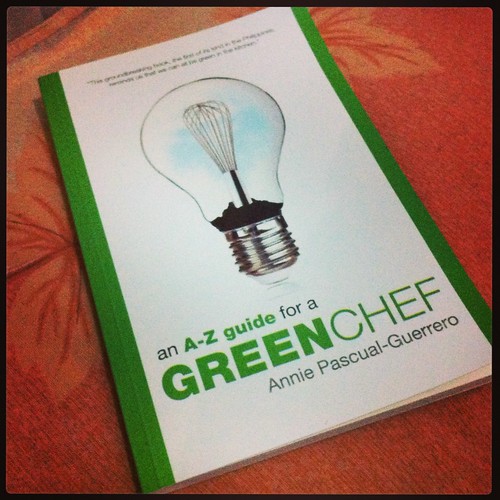I got this book from my boss. As soon as she finished reading it, she immediately thought of giving it away to us. No one in the office wanted it, so I took it. I’d like to think our boss was just being generous (she always is). But I also couldn’t shake the thought that maybe, she just wanted more people to know about the wealth of knowledge found in the book. Whatever her reason was, I’m glad she shared this book with me.
Annie Pascual-Guerrero is the founder of Center for Culinary Arts, the pioneer culinary school in the Philippines. Aside from being a culinary expert, she is also an environmentalist. Her book titled “An A-Z Guide for a Green Chef” teaches chefs and non-chefs alike on how to go green in the kitchen. I liked how she sounded in the book because you could really feel her staunch advocacy on the preservation of the environment which, according to her, starts in the kitchen (at home or in commercial/industrial ones).
Below are some food tidbits I learned from the book:
1. Arugula and lemon are alkaline food which are very good for the body.
2. Green and sprouted potatoes contain solanine, a toxic substance that can cause diarrhea, cramps and fatigue to humans.
3. In general, peas, beans, and lentils are called pulses.
4. Peanuts are actually a legume and not a nut. (Oh, that’s why peanuts are called “roasted highland legumes” in a Manny Pacquiao beer commercial before!)
5. Pandan leaves keep the roaches away. Try putting a bunch of them under your sink and see the effect instantly.
6. Brazil is the largest producer of orange juice in the world.
7. When serving onions raw, soak them in vinegar for 30 minutes to retain the crunchiness and make the sharp flavor gone.
8. Tomatoes were legally declared a vegetable in the US in 1893.
9. Eggs are a “complete protein” food, a nutrient powerhouse with nine essential amino acids, Vitamin A, B and D, zinc and iron.
10. For the crispiest slaw, shred cabbage then immerse in ice water for about an hour, then drain well and dry.
11. Ice cream is said to have originated in China, with snow probably used as the base.
12. Add only acid food such as tomatoes, lemon juice and wine after the beans have softened. Otherwise, the beans will take a much longer time to cook.
I loved that aside from the A-Z kitchen guide where she talked about ingredients and their nature and best uses, she also explained the various cooking methods we use today as well as what they do to and how they affect the flavor of our food.
I appreciate Ms. Pascual-Guerrero’s efforts to write this book not only to profit from it as an author but also to spread the message (and benefits) of green living to all. Like her, I believe that green is the way to go. Observing green practices at home is easy, but you will need to have a great amount of discipline to maintain it for life. I plan to go green in the kitchen soon but I’ll do it one step at a time and I’ll start by convincing the hubby to work with me on it. 🙂

